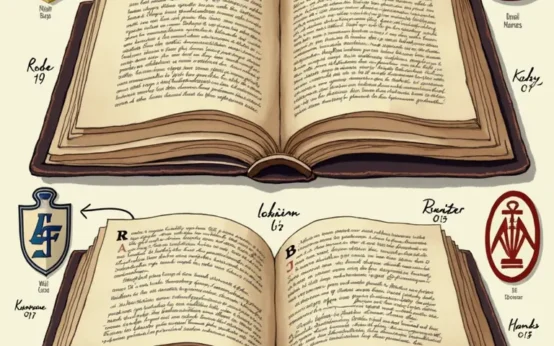We use them every day, often without a second thought. Phrases like “break a leg,” “bite the bullet,” “cost an arm and a leg,” and “raining cats and dogs” pepper our conversations, adding color and nuance to our speech. But have you ever wondered where these curious expressions come from? Idioms, those unique turns of phrase whose meanings aren’t deducible from the literal definitions of their constituent words, are fascinating windows into history, culture, and the evolution of language. They’re linguistic fossils, preserving remnants of past practices, beliefs, and societal norms. This article will delve into the captivating origins of some of the most common idioms in the English language, tracing their roots back through time and exploring the stories behind their enduring popularity.
The Theatrical Roots of “Break a Leg”
Perhaps one of the most paradoxical idioms, “break a leg” is a traditional way to wish a performer good luck. It seems counterintuitive – why would you wish harm on someone before a performance? The origin is surprisingly complex, with several competing theories. One popular explanation stems from the world of theater and superstition. Actors, notoriously superstitious, believed that directly wishing someone “good luck” would actually bring about the opposite result. Saying “break a leg” was a way of warding off bad luck by invoking its opposite.
Another theory links the phrase to the days when audiences would stomp their feet and clap vigorously to show their appreciation. The more enthusiastic the applause, the more likely the performers were to receive financial rewards – often in the form of coins tossed onto the stage. To “break a leg” meant to be called back for numerous curtain calls, effectively breaking the leg of the stage through repeated bows and applause. A further suggestion arises from the practice of stage legs, the side supports of the stage. A performer who successfully crossed the ‘leg’ to receive applause was considered to have ‘broken’ it with their performance. Regardless of the precise origin, the idiom persists as a heartfelt (though oddly phrased) expression of encouragement in the performing arts.
“Bite the Bullet”: Facing Adversity with Stoicism
“Bite the bullet” means to face a difficult or unpleasant situation with courage and stoicism. Its origins are firmly rooted in the pre-anesthetic era of battlefield surgery. Before the advent of modern pain relief, soldiers undergoing medical procedures, often amputations or the removal of bullets, were given a bullet to bite down on to help them endure the excruciating pain. The act of biting down on something hard provided a physical distraction and a way to suppress screams.
Historical accounts from the 19th century confirm this practice. Writer and physician Arthur Conan Doyle, author of the Sherlock Holmes stories, vividly describes the use of bullets in his novel The Sign of Four. The idiom, therefore, is a direct reflection of the harsh realities faced by soldiers in a time before modern medicine. It symbolizes enduring hardship with fortitude and suppressing outward displays of pain.
“Cost an Arm and a Leg”: The Price of Progress and Loss
This idiom, meaning something is extremely expensive, has a more complex and evolving history. While often attributed to the aftermath of World War I, where soldiers frequently lost limbs in battle and faced substantial medical bills, its origins predate the conflict. One theory suggests it originated in the American West during the 19th century. Photographers charged exorbitant fees for portrait sessions, and a full-body portrait – requiring more time and effort – could literally “cost an arm and a leg” in terms of the photographer’s time and resources.
Another possibility links the phrase to the practice of ship chandlers overcharging sailors for essential supplies. The loss of a limb at sea was a significant risk, and the cost of replacing lost equipment or receiving medical care could be astronomical. The phrase gained traction in the 20th century, becoming a common expression to describe anything prohibitively expensive, often with the implication that the price is disproportionate to the value received.
“Raining Cats and Dogs”: Myth, Meteorology, and Medieval Sanitation
The image of cats and dogs falling from the sky is, thankfully, not a literal one. “Raining cats and dogs” describes a particularly heavy downpour. Its origins are shrouded in mystery, with several fascinating (and sometimes gruesome) theories. One explanation connects to Norse mythology. Cats were associated with witches and storms, while dogs were linked to the Norse god Odin, who was often depicted with dogs and represented wind. Therefore, a storm with heavy rain and strong winds was seen as “raining cats and dogs” – a metaphorical representation of the forces of nature unleashed.
A more practical, albeit less romantic, theory stems from medieval sanitation practices. In the past, homes often had thatched roofs which provided shelter for animals, including cats and dogs. During heavy rainfall, the roofs would become slippery, and the animals would sometimes fall off, giving the impression that it was “raining cats and dogs.” Furthermore, poor drainage systems in medieval cities led to streets becoming flooded with waste, often including animal carcasses. After a particularly heavy rain, these remains would be washed through the streets, creating a similarly unsettling image. Regardless of the true origin, the idiom vividly conveys the intensity of a torrential downpour.
“Spill the Beans”: From Ancient Greece to Modern Secrets
“Spill the beans” means to reveal a secret. Its origin is surprisingly specific and linked to an ancient Greek voting practice. In ancient Greece, decisions were often made through secret ballots. Beans – white for “yes” and black for “no” – were placed into an urn. If someone accidentally (or intentionally) knocked over the urn, “spilling the beans,” the results of the vote would be revealed prematurely.
This practice continued in other forms throughout history. In the Middle Ages, beans were used in similar voting systems. The act of “spilling the beans” became synonymous with revealing a secret before it was intended to be disclosed. The idiom, therefore, has a direct connection to democratic processes and the importance of confidentiality.
“Kick the Bucket”: A Grim History with Uncertain Roots
“Kick the bucket” is a euphemism for death. Its origins are debated, but the most plausible explanation relates to methods of slaughtering animals. Specifically, it’s believed to stem from the practice of hanging pigs by their feet from a beam to slaughter them. The pigs would instinctively struggle, kicking the bucket (or pail) placed beneath them to collect the blood. Therefore, “kicking the bucket” became associated with the final moments of life.
Another theory suggests it refers to a specific type of wooden frame used to hang animals, which was known as a ‘bucket.’ When an animal was hung, it would kick against the frame. While less common, this theory also contributes to understanding the idiom’s origins. The phrase, despite its morbid connotations, is often used with a degree of gallows humor.
“Mad as a Hatter”: Mercury and Millinery
“Mad as a hatter” describes someone who is eccentric or insane. This idiom is directly linked to the 18th and 19th-century hat-making industry. Hatters used mercury in the process of making felt hats, particularly top hats. Prolonged exposure to mercury vapor caused mercury poisoning, which resulted in neurological damage, including tremors, irritability, and hallucinations.

Hatters were therefore frequently observed exhibiting erratic behavior, leading to the association between hat-making and madness. Lewis Carroll’s character, the Mad Hatter, in Alice’s Adventures in Wonderland, further popularized the idiom, cementing its connection to eccentricity and insanity. The history of pigments used in hat-making also reveals the dangerous chemicals involved.
“Red Herring”: Distraction and Deception
A “red herring” is a misleading clue or piece of information intended to distract from the real issue. The origin of this idiom is surprisingly literal. In the 19th century, strong-smelling smoked (and therefore reddish) herrings were used by trainers of hunting dogs to test their scent-tracking abilities.
The trainer would drag a red herring across the trail of the animal being hunted, to see if the dog would be distracted by the strong scent and abandon the original pursuit. If the dog followed the red herring, it indicated a lack of focus and a susceptibility to distraction. The idiom, therefore, originated as a practical training technique and evolved into a metaphor for any deliberate attempt to mislead or divert attention.
“Read Between the Lines”: Subtext and Hidden Meanings
“Read between the lines” means to understand something that is not explicitly stated. Its origins are thought to lie in the practice of early printers and scribes. In the Middle Ages, monks painstakingly copied manuscripts by hand. To save space and parchment, they sometimes wrote very closely together, with limited spacing between the lines.
Readers were required to carefully examine the text, essentially “reading between the lines” to decipher the meaning. Over time, the phrase evolved into a metaphor for understanding implied meanings, hidden messages, and subtle nuances in communication. Understanding the evolution of writing gives context to the challenges faced by early readers.
“Fly Off the Handle”: Tools and Temperament
“Fly off the handle” means to lose one’s temper suddenly and unexpectedly. The origin of this idiom is rooted in the world of carpentry. Axes and other tools with handles were often constructed with the head securely attached to the wooden handle. However, if the handle became loose or fractured, the head could “fly off” with considerable force, posing a danger to anyone nearby.
The phrase, therefore, is a vivid metaphor for a sudden and uncontrolled outburst of anger. It suggests a loss of control and a potentially destructive reaction. The image of a tool malfunctioning provides a potent visual representation of a temper flaring.
“Take it With a Grain of Salt”: Skepticism and Ancient Wisdom
“Take it with a grain of salt” means to view something with skepticism or to not take it too seriously. This idiom has a surprisingly ancient origin, dating back to Pliny the Elder, a Roman author and naturalist. In his work Natural History, Pliny described a recipe for an antidote to poison, which included taking a grain of salt with the toxic substance.
The salt was believed to help neutralize the poison or make it less harmful. Over time, the phrase evolved into a broader expression of caution and skepticism. It suggests that while something may contain an element of truth, it should be evaluated critically and not accepted at face value. Early cartography provides another example where critical evaluation was key.
“Under the Weather”: Maritime Origins
“Under the weather” means feeling unwell or sick. Its origins lie in maritime terminology. Sailors who were feeling ill were often sent “below deck” – literally “under the weather” – to recover. The lower decks of a ship offered shelter from the harsh elements, but were also cramped, damp, and unpleasant.
Therefore, being “under the weather” became associated with feeling sick and needing to seek refuge from the storm, both literally and figuratively. The phrase reflects the challenging conditions faced by sailors and the importance of seeking shelter when unwell.
The Enduring Power of Idioms
As we’ve seen, idioms aren’t just random collections of words; they’re historical artifacts, linguistic snapshots of past cultures, and reflections of human experience. They offer a unique perspective on how language evolves and how societies change. Understanding the origins of idioms not only enhances our appreciation for the richness of the English language but also provides valuable insights into the history, customs, and beliefs of those who came before us.
The study of idioms is a fascinating journey through time, revealing the enduring power of language to preserve and transmit cultural knowledge. From the battlefields of the past to the theatrical stages of today, these expressions continue to resonate with us, adding depth and color to our everyday conversations. The evolution of measurement systems mirrors the way idioms change over time. And, considering how much we learn through play, the physics of play highlights how even seemingly simple activities shape our understanding of the world. Finally, consider the history of mapmaking as another example of how humans attempt to understand and represent their world.


 The Curious Lexicon of Lost Trades
The Curious Lexicon of Lost Trades  The Surprisingly Consistent Etymology of Place Names – Uncovering Stories in Street & Town Origins
The Surprisingly Consistent Etymology of Place Names – Uncovering Stories in Street & Town Origins  The Surprisingly Consistent Etymology of Food Names: From Origins to Our Plates
The Surprisingly Consistent Etymology of Food Names: From Origins to Our Plates  The Surprisingly Consistent Etymology of Brand Names – How History Shaped What We Buy
The Surprisingly Consistent Etymology of Brand Names – How History Shaped What We Buy  The Surprisingly Consistent Origins of Common Last Names – Tracing Ancestry Through Etymology
The Surprisingly Consistent Origins of Common Last Names – Tracing Ancestry Through Etymology  The Surprisingly Universal Grammar of Jokes: Why Humor Works Across Cultures
The Surprisingly Universal Grammar of Jokes: Why Humor Works Across Cultures